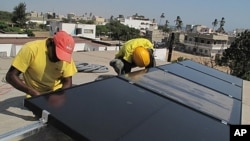It's still early on in Senegal's nine-month-long dry season and, as usual, there's not a cloud in the sky. In a West African nation where growing energy demands far outweigh supply, such abundant sunlight, some say, is the obvious solution to crippling power cuts that result from its aging infrastructure.
Senegal's rolling power outages hinder progress in many sectors, especially in the administrative and financial capital of Dakar. But today a Spanish solar-power company, Prosolia, is installing panels on a vocational school that prepares youth for the city's booming construction industry.
According to Yerogallo Kamara, the school's director, when power goes out, students stop studying.
"They are dependent on electricity at the school, and if the outages persist, the program will be at risk and that will reflect badly on them through the upcoming examinations," says a translator on Kamara's behalf, adding that the traditional solution to this problem has been gas-powered generators, which can be heard intermittently throughout Dakar and the rest of the country.
The generators are essentially miniature versions of the ones used by Senelec, the government-owned utility, which means they are subject to the same steadily rising fuel, maintenance and distribution costs that make solar power an attractive supplement to, or replacement for, traditional sources of energy.
A question of viability
Luc Severi is the general manager of Solar Now, a Dutch company that provides solar energy to individuals in rural communities, which comprise the majority of Senegal's population and the majority of Senelec's problems.
"There is a consensus that electrifying everyone with the national grid is not an option because it's economically not viable," he says.
Explaining that 65 percent of the population is off the grid, Severi says solar can provide the demographic a cheap, clean source of energy that is produced on site.
For Senegal's Sahel region, he adds, solar would prove an especially cost-effective solution.
"Over the course of one day, you've got 5 1/2 hours that you get maximum capacity from the sunlight," he says. "In other countries - for example, in Europe and in the States, that's between two or three, sometimes four hours."
Legislative obstacles
The country's political climate seems equally conducive to solar power. In December of 2010, Senegal passed a law aiming to produce 15 percent of total energy by renewable production methods, and there are currently about 50 solar-power agencies already within its borders vying for a piece of the promising market.
But the market's prohibitively high cost of initial investment is forcing disproportionate growth. To combat this, most companies have formed credit plans, and Prosolia recently signed a marketing protocol with the Banking Company of West Africa to finance solar power systems.
The other major obstacle, according to Severi, is lack of good information about solar energy in Senegal.
"Often people have never heard of solar energy or what they have heard is wrong, which is actually even worse because it's hard to go against the popular beliefs," he says.
Educating the public
Solar Now and other companies have launched campaigns to educate the public about solar energy, but nothing works better than visibility according to Mamadou Sow, CEO of Sustainable Power Electric Company (SPEC). The Senegal-based company recently fulfilled a government contract to provide solar-powered street lamps in a densely populated area of Dakar.
"There is now more awareness among people all over Senegal that there are alternative sources of power that must be considered and that solar energy can play a role in providing a solution to Senegal’s chronic power shortages," says a translator on Sow's behalf.
Senelec, the state power utility, could not be reached for comment, but Sow, who hopes partner with the company, has spoken with representatives. Although it is only a supplemental energy source now, he says, the state power company recognizes the potential of solar and will likely invest in the future.
Senegal's Shining Solution to Blackouts











